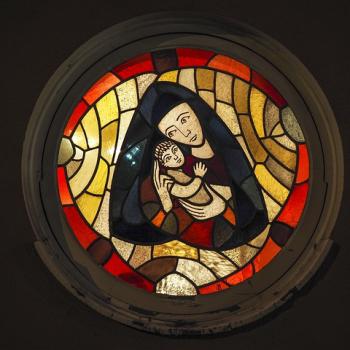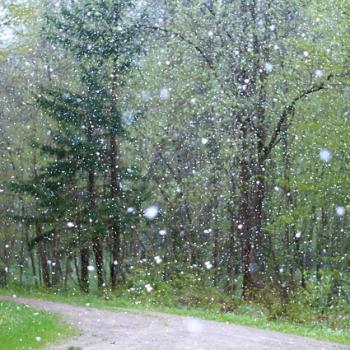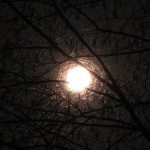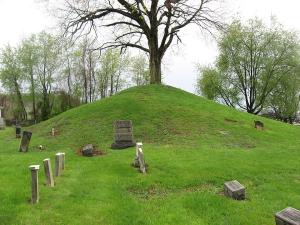
I went down to Tiltonsville, to see the ancient burial mound.
I’d been looking for more things to see around the Ohio river valley, now that Adrienne is so happy in school and I’m not a homeschooling mother anymore. I’ve decided to homeschool myself, to take myself on field trips and teach myself things. I was excited when I found out there was a burial mound of the prehistoric Adena people very close by Steubenville, about twenty minutes away. I’d never heard of it before. It seems that when settlers first came to this side of the river, they buried their dead around a suspiciously neat cone-shaped hill that was the perfect center for a graveyard. One day, some natural erosion on the hill exposed ancient bones including a skull that was deformed in the way the Adena people were known to do on purpose. The mound’s never been excavated, but every so often it erodes again, and they find another Adena skull.
I don’t think anyone knows how old the mound is. The Adena lived in this part of Ohio from about 500 BC to about AD 500, and no European ever met one. We only know about them from their tombs. The marked graves of the settlers are from the 1800s, and not all of those are legible either. I don’t know if anyone knows exactly how many people are buried on that spot.
Tiltonsville is a village much smaller than Steubenville. The roads are extremely narrow, so it’s easy to get lost. I drove to the wrong end of town and had to ask for directions, even with my GPS on. The spot marked “Hodgens Cemetery” on Mound Street is wrong, for the record. You need to go to the spot marked “Indian Mound Cemetery,” behind Smith Oil.
It was a funny little place, just a small plot of land the size of my backyard, surrounded by a chain link fence, stuck between that gas station and some residential houses.
There was a sign on the fence forbidding, among other activities, “sled riding.”
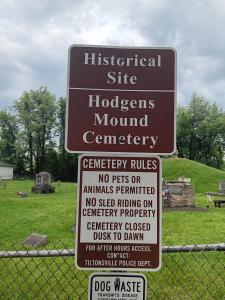
Immediately, I wanted to know the story about the whoever who had attempted to go sledding on the ancient burial mound. I could just picture them in my mind: three boys on an old fashioned wooden sled with metal runners, one older than the other two. The older boy was the bad one, egging the other two on, calling them chicken. The snow was so thick that you could barely see the headstones themselves, only lumps where the snow covered them, and it was a difficult trudge up to the top in the shadow of that great big tree. They sat down one-two-three, sitting up, the one behind gripping the one in front with their knees. The sled wouldn’t budge at first but then went down all at once; the one in front steered sharply to avoid the mounds where the headstones were, and didn’t quite make it. The sled hit that grave over to one side, the one that’s leaning crooked. The boys went flying. The very littlest one was bleeding out of a bright red cut in his forehead, staining the snow. The other two begged him to be quiet, but of course he started howling. Next thing you know, the whole town was there, and they were angry.
I shook myself out of my reverie. There was no snow, no sled, no boys, no angry townsfolk; just a tiny odd quadrangle of a graveyard in the midst of residential houses, with a mound in the middle.
There was no tree on the hill, only a stump.
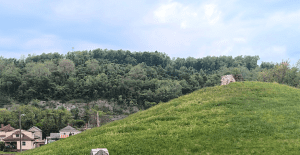
I made my way around the hill, reading headstones when I could. Many of them were too worn to make out.
There was a small stone near the base of the hill that had a little American flag stuck beside it. Usually that means the person buried there is a veteran, but this one wasn’t. It was a baby, aged just two years., buried in the late 1800s. Again, my mind envisioned people who weren’t there: a woman about my age in a calico dress, leaning over a square of bare soil, not crying outwardly. Somewhere off behind her are the townspeople, singing a hymn. “Farewell, my friends, I’m bound for Canaan, I’m trav’ling through the wilderness; Your company has been delightful, you, who doth leave my mind distressed. I go away, behind to leave you; perhaps never to meet again, but if we never have the pleasure, I hope we’ll meet on Canaan’s land.”
And then the funeral was over, and there was nobody in the cemetery but me.
I rounded the side of the mound, cautious, not wanting to get too close. Somebody once told me that it’s disrespectful to walk on graves. You have to walk BETWEEN the graves. But I didn’t know how to do that on such a small plot, where so many people had been buried for a thousand years or more. Would it be right to walk on that hill? Would the people inside of it mind? Do graves expire? Is there a set time in history when a tomb becomes archeological site and not a tragedy?
I thought of the Egyptian mummy I’d seen in the Carnegie museum with The Lost Girl’s children, and of their revulsion when they were told that these were real human bones. I thought of the Lost Girl telling me to tell the children that the taxidermy lion they were petting had died of old age, because one of her boys always cried when he thought about hunting. I thought of the Lost Girl again, and wished I was dead.
A brown rabbit with a bright white tail ran out in front of me, away from the mound, between two graves, and under the fence.
On the other side of the hill was a line of headstones, one large and four small. In my head, I saw a family: a respectable father with graying hair in breeches and rimless spectacles. His wife, much younger than he, short enough to be a child herself. Two children, a boy and a girl, pale and sickly. They were there, and then they weren’t.
The line of graves was surrounded by ranunculus, commonly known as buttercups. The yellow blossoms dotted the short gras on all sides. I wondered if they had grown that way by some biological accident or if they had been planted.
In my mind’s eye, I saw the mother of that family again, older, leaning over three gravestones instead of four, sprinkling seeds. “David the king was grieved and moved; He went to his chamber, his chamber, and wept; And as he went, he wept and said, O my son! O my son! Would to God I had died, Would to God I had died, For thee, O Absalom, my son, my son!”
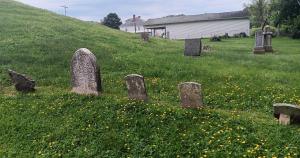
Was the lady who planted the buttercups singing?
No, it was me. I was singing shapenote hymns softly to myself, as I do when I’m alone.
Further around the mound was another grave with an American flag stuck beside it. This one was carefully maintained, with the name and date easy to read: John Tilton, VA Militia, Revolutionary War, 1737-1810.
John Tilton was the founder of Tiltonsville, of course. He paid just under four thousand dollars for the land, at an auction in Pittsburgh. The deed was signed by John Adams himself. I don’t know what John Tilton did to distinguish himself in the American revolution, but he was exactly my age when the Declaration of Independence was signed. For almost half his life, America was England, and then it was someplace else. Before America was England, America belonged to other people.
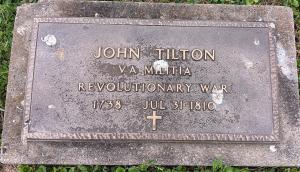
I looked up at the mound and the tree stump. In all the photographs I’d seen, the mound was topped with a great big tree. The descriptions of the mound involved pioneers finding a hill with a tree at the very top. I wondered when the tree had fallen down, and if anyone had mourned it. I wondered what they had done with the lumber. Who had planted that tree? It couldn’t have been old enough to have been planted by the Adena.
There were the Adena people, in my mind’s eye. I don’t know what an Adena looks like, so my mind made them look like the Wyandot and the Lenape, the people who were still here when the settlers arrived. There were four or five Adena people walking around the side of the mound to an opening, bringing the smallest of bodies to rest here– a child, like the two-year-old child whose headstone was hidden around the other side.
And am I born to die? To lay this body down! And must my trembling spirit fly Into a world unknown? A land of deepest shade, Unpierced by human thought; The dreary regions of the dead, Where all things are forgot!
Of course the Adena didn’t sing Sacred Harp hymns. Somebody else was, in my imagination.
Then the fantasy was over. Nobody was there at all. I was a ridiculous middle-aged woman, standing in a grassy patch in between houses and a gas station, in the Ohio valley, in the twenty-first century, in a world that is burning to death.
I went home as the rain began.
Mary Pezzulo is the author of Meditations on the Way of the Cross, The Sorrows and Joys of Mary, and Stumbling into Grace: How We Meet God in Tiny Works of Mercy.




